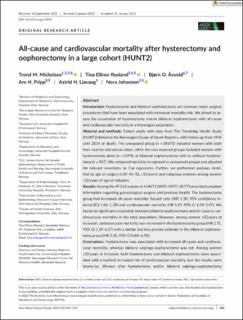| dc.description.abstract | Introduction: Hysterectomy and bilateral oophorectomy are common major surgical
procedures that have been associated with increased mortality risk. We aimed to as-
sess the association of hysterectomy and/or bilateral oophorectomy with all-cause
and cardiovascular mortality in a Norwegian population.
Material and methods: Cohort study with data from The Trøndelag Health Study
(HUNT2) linked to the Norwegian Cause of Death Registry, with follow-up from 1996
until 2014 or death. The unexposed group (n = 18 673) included women with both
their ovaries and uterus intact, while the two exposed groups included women with
hysterectomy alone (n = 1199), or bilateral oophorectomy with or without hysterec-
tomy (n = 907). We compared mortality in exposed vs unexposed groups and adjusted
for relevant covariates by Cox regression. Further, we performed analyses strati-
fied by age at surgery (≤39, 40–52, ≥53 years) and subgroup analyses among women
≤52 years of age at inclusion.
Results: Among the 47 312 women in HUNT2 (1995–1997), 20 779 provided complete
information regarding gynecological surgery and previous health. The hysterectomy
group had increased all-cause mortality (hazard ratio [HR] 1.30, 95% confidence in-
terval [CI] 1.06–1.58) and cardiovascular mortality (HR 1.47, 95% CI 1.09–1.97). We
found no significant association between bilateral oophorectomy and all-cause or car-
diovascular mortality in the total population. However, among women ≤52 years at
inclusion, cardiovascular mortality was increased in the hysterectomy group (HR 2.71,
95% CI 1.19–6.17) with a similar, but less precise estimate in the bilateral oophorec-
tomy group (HR 2.42, 95% CI 0.84–6.93).
Conclusions: Hysterectomy was associated with increased all-cause and cardiovas-
cular mortality, whereas bilateral salpingo-oophorectomy was not. Among women
≤52 years at inclusion, both hysterectomy and bilateral oophorectomy were associ-
ated with a twofold increased risk of cardiovascular mortality, but the results were
imprecise. Women after hysterectomy and/or bilateral salpingo-oophorectomy constitute a group with increased cardiovascular mortality that may need closer at-
tention to cardiovascular disease risk from the healthcare system to ensure timely and
effective preventive interventions. | en_US |

